Cathay Pacific Airways: Analysis & Strategy
VerifiedAdded on 2020/04/21
|15
|4152
|700
AI Summary
This assignment delves into a comprehensive analysis of Cathay Pacific Airways, a leading airline company. It utilizes the PESTLE framework to assess the external factors influencing the airline's operations and employs SWOT analysis to evaluate its internal strengths, weaknesses, opportunities, and threats. The analysis sheds light on key challenges and strategic considerations for Cathay Pacific in navigating the dynamic global aviation landscape.
Contribute Materials
Your contribution can guide someone’s learning journey. Share your
documents today.
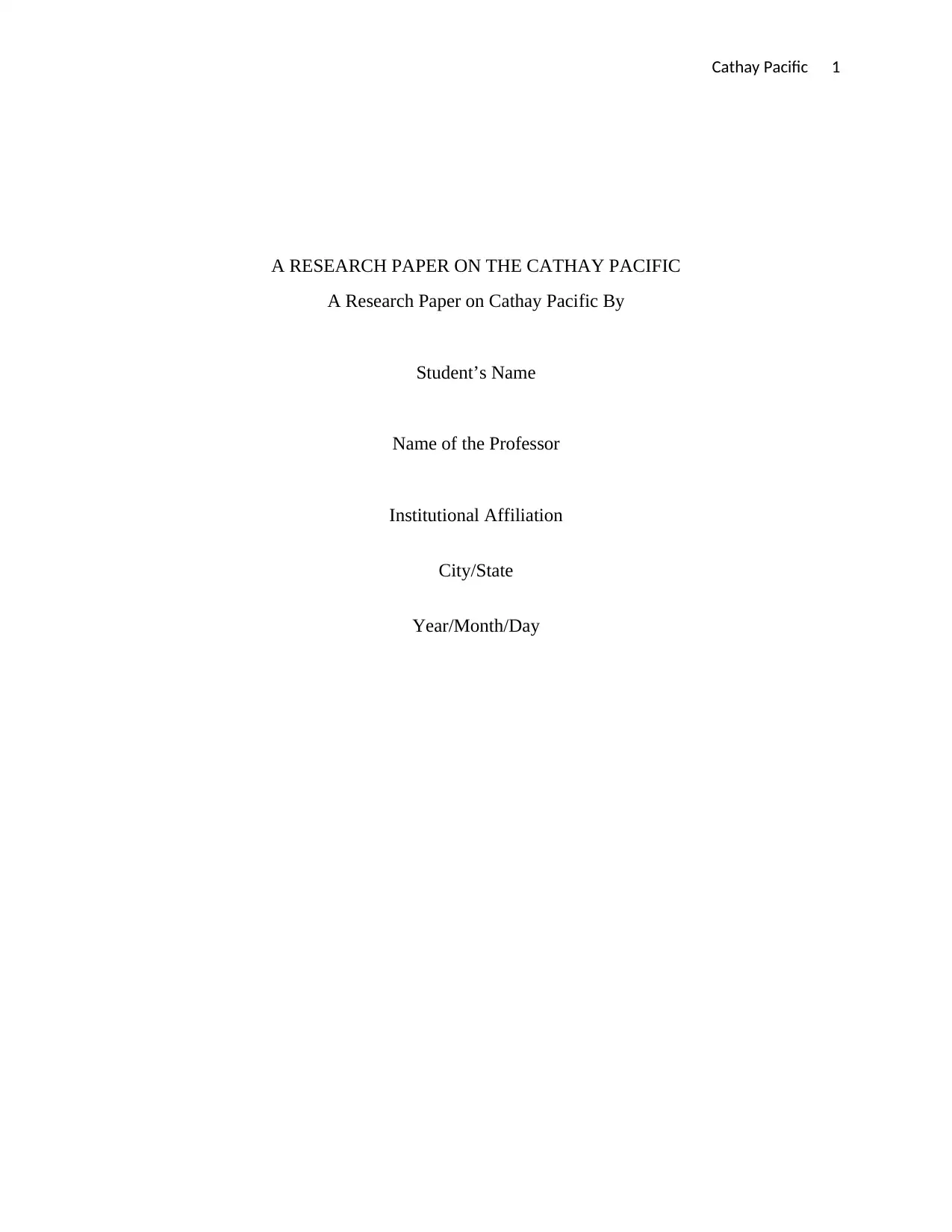
Cathay Pacific 1
A RESEARCH PAPER ON THE CATHAY PACIFIC
A Research Paper on Cathay Pacific By
Student’s Name
Name of the Professor
Institutional Affiliation
City/State
Year/Month/Day
A RESEARCH PAPER ON THE CATHAY PACIFIC
A Research Paper on Cathay Pacific By
Student’s Name
Name of the Professor
Institutional Affiliation
City/State
Year/Month/Day
Secure Best Marks with AI Grader
Need help grading? Try our AI Grader for instant feedback on your assignments.
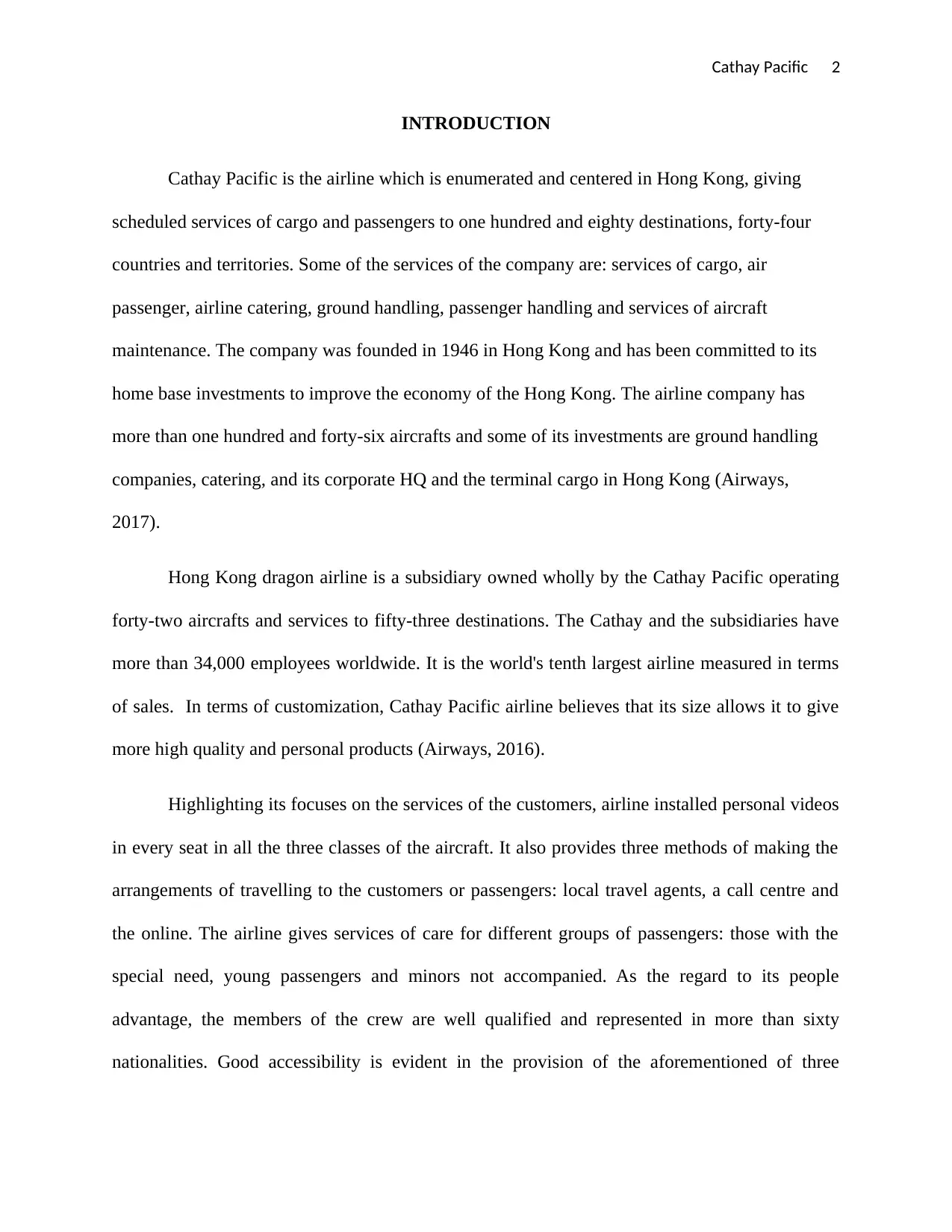
Cathay Pacific 2
INTRODUCTION
Cathay Pacific is the airline which is enumerated and centered in Hong Kong, giving
scheduled services of cargo and passengers to one hundred and eighty destinations, forty-four
countries and territories. Some of the services of the company are: services of cargo, air
passenger, airline catering, ground handling, passenger handling and services of aircraft
maintenance. The company was founded in 1946 in Hong Kong and has been committed to its
home base investments to improve the economy of the Hong Kong. The airline company has
more than one hundred and forty-six aircrafts and some of its investments are ground handling
companies, catering, and its corporate HQ and the terminal cargo in Hong Kong (Airways,
2017).
Hong Kong dragon airline is a subsidiary owned wholly by the Cathay Pacific operating
forty-two aircrafts and services to fifty-three destinations. The Cathay and the subsidiaries have
more than 34,000 employees worldwide. It is the world's tenth largest airline measured in terms
of sales. In terms of customization, Cathay Pacific airline believes that its size allows it to give
more high quality and personal products (Airways, 2016).
Highlighting its focuses on the services of the customers, airline installed personal videos
in every seat in all the three classes of the aircraft. It also provides three methods of making the
arrangements of travelling to the customers or passengers: local travel agents, a call centre and
the online. The airline gives services of care for different groups of passengers: those with the
special need, young passengers and minors not accompanied. As the regard to its people
advantage, the members of the crew are well qualified and represented in more than sixty
nationalities. Good accessibility is evident in the provision of the aforementioned of three
INTRODUCTION
Cathay Pacific is the airline which is enumerated and centered in Hong Kong, giving
scheduled services of cargo and passengers to one hundred and eighty destinations, forty-four
countries and territories. Some of the services of the company are: services of cargo, air
passenger, airline catering, ground handling, passenger handling and services of aircraft
maintenance. The company was founded in 1946 in Hong Kong and has been committed to its
home base investments to improve the economy of the Hong Kong. The airline company has
more than one hundred and forty-six aircrafts and some of its investments are ground handling
companies, catering, and its corporate HQ and the terminal cargo in Hong Kong (Airways,
2017).
Hong Kong dragon airline is a subsidiary owned wholly by the Cathay Pacific operating
forty-two aircrafts and services to fifty-three destinations. The Cathay and the subsidiaries have
more than 34,000 employees worldwide. It is the world's tenth largest airline measured in terms
of sales. In terms of customization, Cathay Pacific airline believes that its size allows it to give
more high quality and personal products (Airways, 2016).
Highlighting its focuses on the services of the customers, airline installed personal videos
in every seat in all the three classes of the aircraft. It also provides three methods of making the
arrangements of travelling to the customers or passengers: local travel agents, a call centre and
the online. The airline gives services of care for different groups of passengers: those with the
special need, young passengers and minors not accompanied. As the regard to its people
advantage, the members of the crew are well qualified and represented in more than sixty
nationalities. Good accessibility is evident in the provision of the aforementioned of three
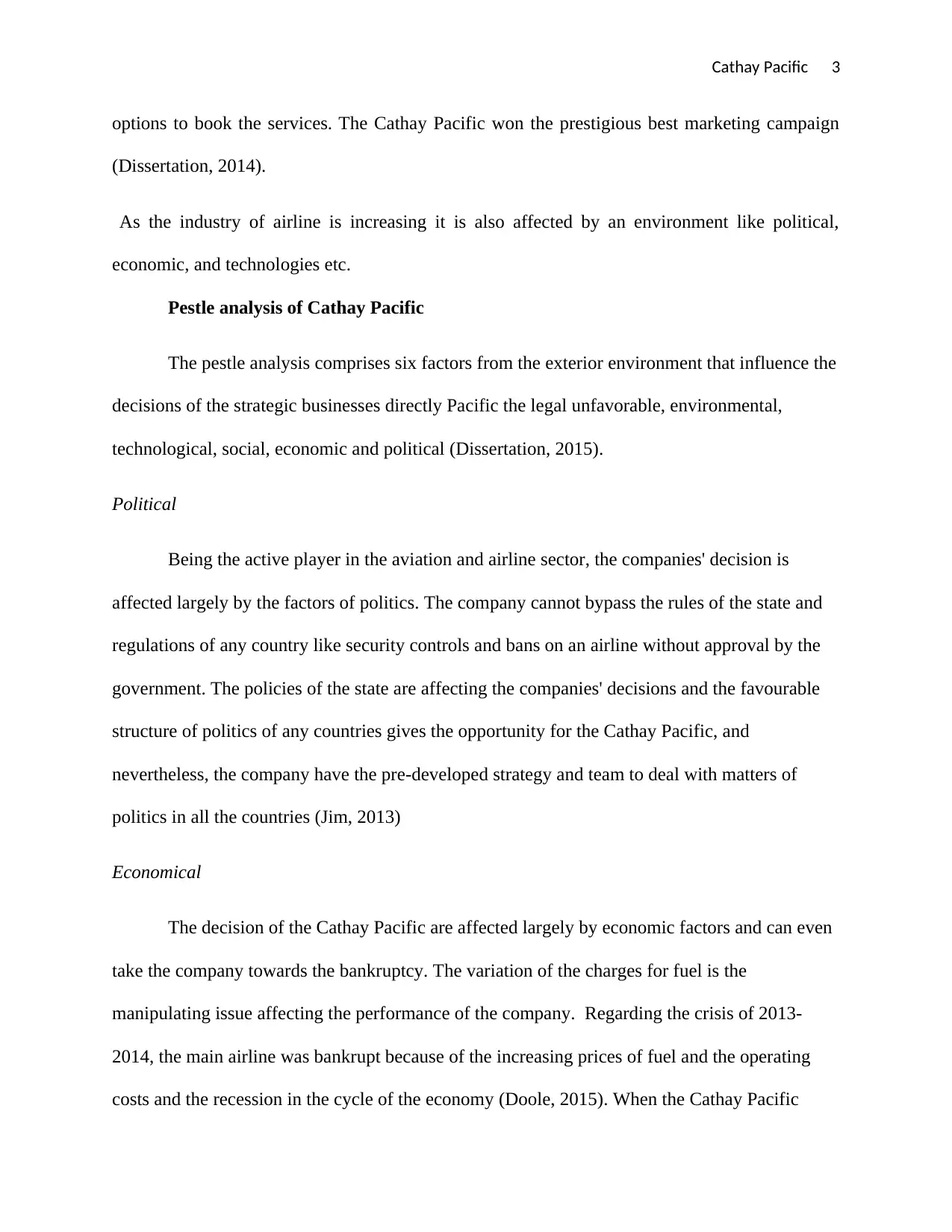
Cathay Pacific 3
options to book the services. The Cathay Pacific won the prestigious best marketing campaign
(Dissertation, 2014).
As the industry of airline is increasing it is also affected by an environment like political,
economic, and technologies etc.
Pestle analysis of Cathay Pacific
The pestle analysis comprises six factors from the exterior environment that influence the
decisions of the strategic businesses directly Pacific the legal unfavorable, environmental,
technological, social, economic and political (Dissertation, 2015).
Political
Being the active player in the aviation and airline sector, the companies' decision is
affected largely by the factors of politics. The company cannot bypass the rules of the state and
regulations of any country like security controls and bans on an airline without approval by the
government. The policies of the state are affecting the companies' decisions and the favourable
structure of politics of any countries gives the opportunity for the Cathay Pacific, and
nevertheless, the company have the pre-developed strategy and team to deal with matters of
politics in all the countries (Jim, 2013)
Economical
The decision of the Cathay Pacific are affected largely by economic factors and can even
take the company towards the bankruptcy. The variation of the charges for fuel is the
manipulating issue affecting the performance of the company. Regarding the crisis of 2013-
2014, the main airline was bankrupt because of the increasing prices of fuel and the operating
costs and the recession in the cycle of the economy (Doole, 2015). When the Cathay Pacific
options to book the services. The Cathay Pacific won the prestigious best marketing campaign
(Dissertation, 2014).
As the industry of airline is increasing it is also affected by an environment like political,
economic, and technologies etc.
Pestle analysis of Cathay Pacific
The pestle analysis comprises six factors from the exterior environment that influence the
decisions of the strategic businesses directly Pacific the legal unfavorable, environmental,
technological, social, economic and political (Dissertation, 2015).
Political
Being the active player in the aviation and airline sector, the companies' decision is
affected largely by the factors of politics. The company cannot bypass the rules of the state and
regulations of any country like security controls and bans on an airline without approval by the
government. The policies of the state are affecting the companies' decisions and the favourable
structure of politics of any countries gives the opportunity for the Cathay Pacific, and
nevertheless, the company have the pre-developed strategy and team to deal with matters of
politics in all the countries (Jim, 2013)
Economical
The decision of the Cathay Pacific are affected largely by economic factors and can even
take the company towards the bankruptcy. The variation of the charges for fuel is the
manipulating issue affecting the performance of the company. Regarding the crisis of 2013-
2014, the main airline was bankrupt because of the increasing prices of fuel and the operating
costs and the recession in the cycle of the economy (Doole, 2015). When the Cathay Pacific
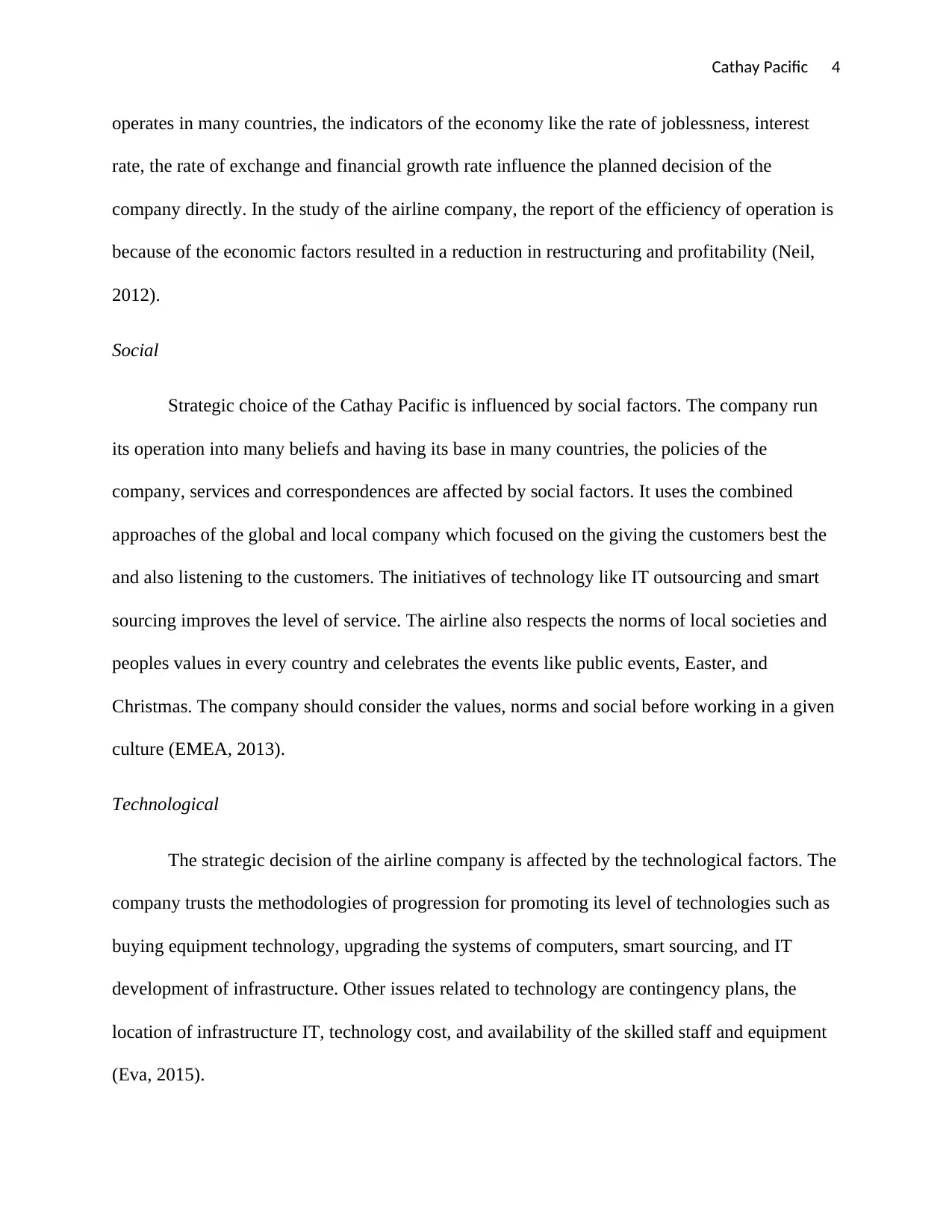
Cathay Pacific 4
operates in many countries, the indicators of the economy like the rate of joblessness, interest
rate, the rate of exchange and financial growth rate influence the planned decision of the
company directly. In the study of the airline company, the report of the efficiency of operation is
because of the economic factors resulted in a reduction in restructuring and profitability (Neil,
2012).
Social
Strategic choice of the Cathay Pacific is influenced by social factors. The company run
its operation into many beliefs and having its base in many countries, the policies of the
company, services and correspondences are affected by social factors. It uses the combined
approaches of the global and local company which focused on the giving the customers best the
and also listening to the customers. The initiatives of technology like IT outsourcing and smart
sourcing improves the level of service. The airline also respects the norms of local societies and
peoples values in every country and celebrates the events like public events, Easter, and
Christmas. The company should consider the values, norms and social before working in a given
culture (EMEA, 2013).
Technological
The strategic decision of the airline company is affected by the technological factors. The
company trusts the methodologies of progression for promoting its level of technologies such as
buying equipment technology, upgrading the systems of computers, smart sourcing, and IT
development of infrastructure. Other issues related to technology are contingency plans, the
location of infrastructure IT, technology cost, and availability of the skilled staff and equipment
(Eva, 2015).
operates in many countries, the indicators of the economy like the rate of joblessness, interest
rate, the rate of exchange and financial growth rate influence the planned decision of the
company directly. In the study of the airline company, the report of the efficiency of operation is
because of the economic factors resulted in a reduction in restructuring and profitability (Neil,
2012).
Social
Strategic choice of the Cathay Pacific is influenced by social factors. The company run
its operation into many beliefs and having its base in many countries, the policies of the
company, services and correspondences are affected by social factors. It uses the combined
approaches of the global and local company which focused on the giving the customers best the
and also listening to the customers. The initiatives of technology like IT outsourcing and smart
sourcing improves the level of service. The airline also respects the norms of local societies and
peoples values in every country and celebrates the events like public events, Easter, and
Christmas. The company should consider the values, norms and social before working in a given
culture (EMEA, 2013).
Technological
The strategic decision of the airline company is affected by the technological factors. The
company trusts the methodologies of progression for promoting its level of technologies such as
buying equipment technology, upgrading the systems of computers, smart sourcing, and IT
development of infrastructure. Other issues related to technology are contingency plans, the
location of infrastructure IT, technology cost, and availability of the skilled staff and equipment
(Eva, 2015).
Secure Best Marks with AI Grader
Need help grading? Try our AI Grader for instant feedback on your assignments.
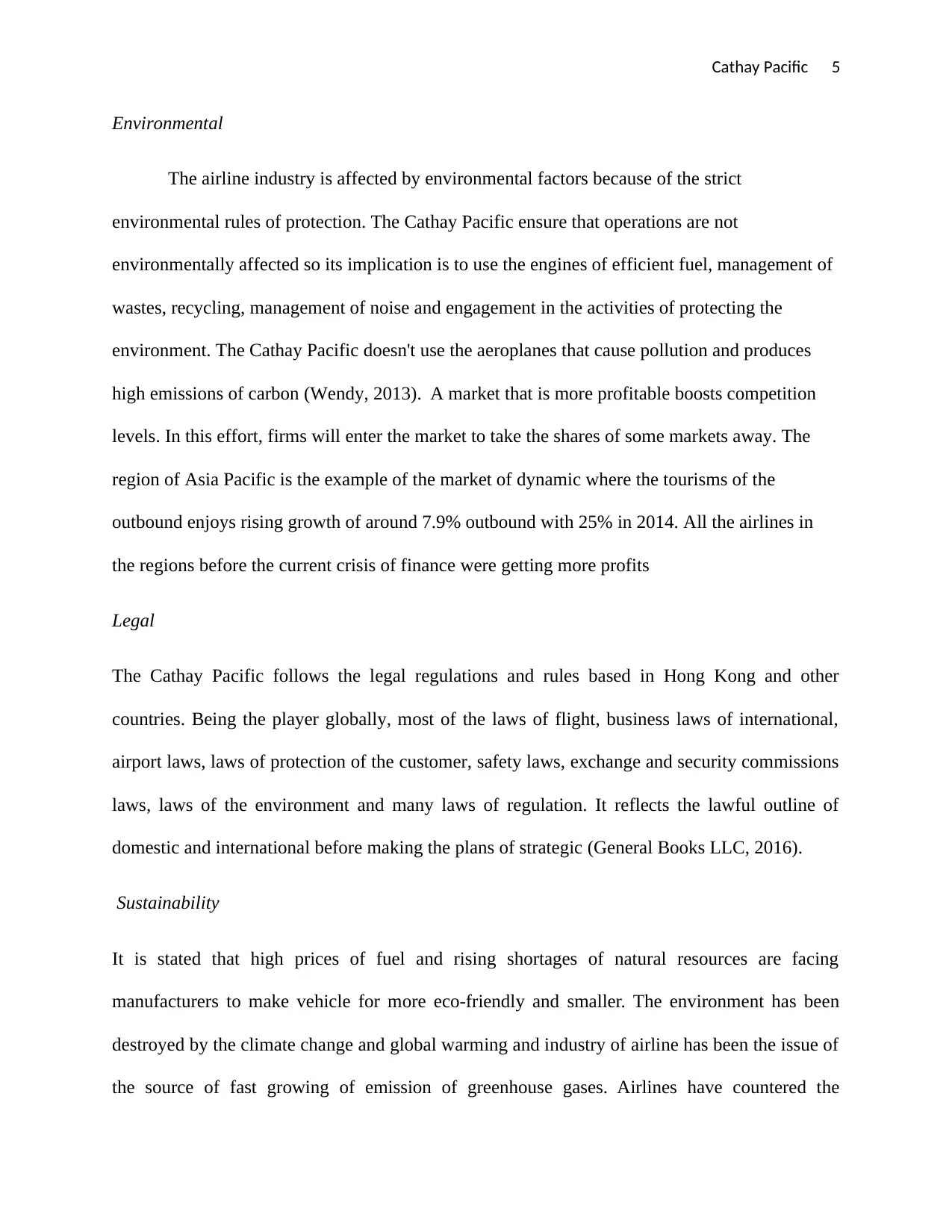
Cathay Pacific 5
Environmental
The airline industry is affected by environmental factors because of the strict
environmental rules of protection. The Cathay Pacific ensure that operations are not
environmentally affected so its implication is to use the engines of efficient fuel, management of
wastes, recycling, management of noise and engagement in the activities of protecting the
environment. The Cathay Pacific doesn't use the aeroplanes that cause pollution and produces
high emissions of carbon (Wendy, 2013). A market that is more profitable boosts competition
levels. In this effort, firms will enter the market to take the shares of some markets away. The
region of Asia Pacific is the example of the market of dynamic where the tourisms of the
outbound enjoys rising growth of around 7.9% outbound with 25% in 2014. All the airlines in
the regions before the current crisis of finance were getting more profits
Legal
The Cathay Pacific follows the legal regulations and rules based in Hong Kong and other
countries. Being the player globally, most of the laws of flight, business laws of international,
airport laws, laws of protection of the customer, safety laws, exchange and security commissions
laws, laws of the environment and many laws of regulation. It reflects the lawful outline of
domestic and international before making the plans of strategic (General Books LLC, 2016).
Sustainability
It is stated that high prices of fuel and rising shortages of natural resources are facing
manufacturers to make vehicle for more eco-friendly and smaller. The environment has been
destroyed by the climate change and global warming and industry of airline has been the issue of
the source of fast growing of emission of greenhouse gases. Airlines have countered the
Environmental
The airline industry is affected by environmental factors because of the strict
environmental rules of protection. The Cathay Pacific ensure that operations are not
environmentally affected so its implication is to use the engines of efficient fuel, management of
wastes, recycling, management of noise and engagement in the activities of protecting the
environment. The Cathay Pacific doesn't use the aeroplanes that cause pollution and produces
high emissions of carbon (Wendy, 2013). A market that is more profitable boosts competition
levels. In this effort, firms will enter the market to take the shares of some markets away. The
region of Asia Pacific is the example of the market of dynamic where the tourisms of the
outbound enjoys rising growth of around 7.9% outbound with 25% in 2014. All the airlines in
the regions before the current crisis of finance were getting more profits
Legal
The Cathay Pacific follows the legal regulations and rules based in Hong Kong and other
countries. Being the player globally, most of the laws of flight, business laws of international,
airport laws, laws of protection of the customer, safety laws, exchange and security commissions
laws, laws of the environment and many laws of regulation. It reflects the lawful outline of
domestic and international before making the plans of strategic (General Books LLC, 2016).
Sustainability
It is stated that high prices of fuel and rising shortages of natural resources are facing
manufacturers to make vehicle for more eco-friendly and smaller. The environment has been
destroyed by the climate change and global warming and industry of airline has been the issue of
the source of fast growing of emission of greenhouse gases. Airlines have countered the
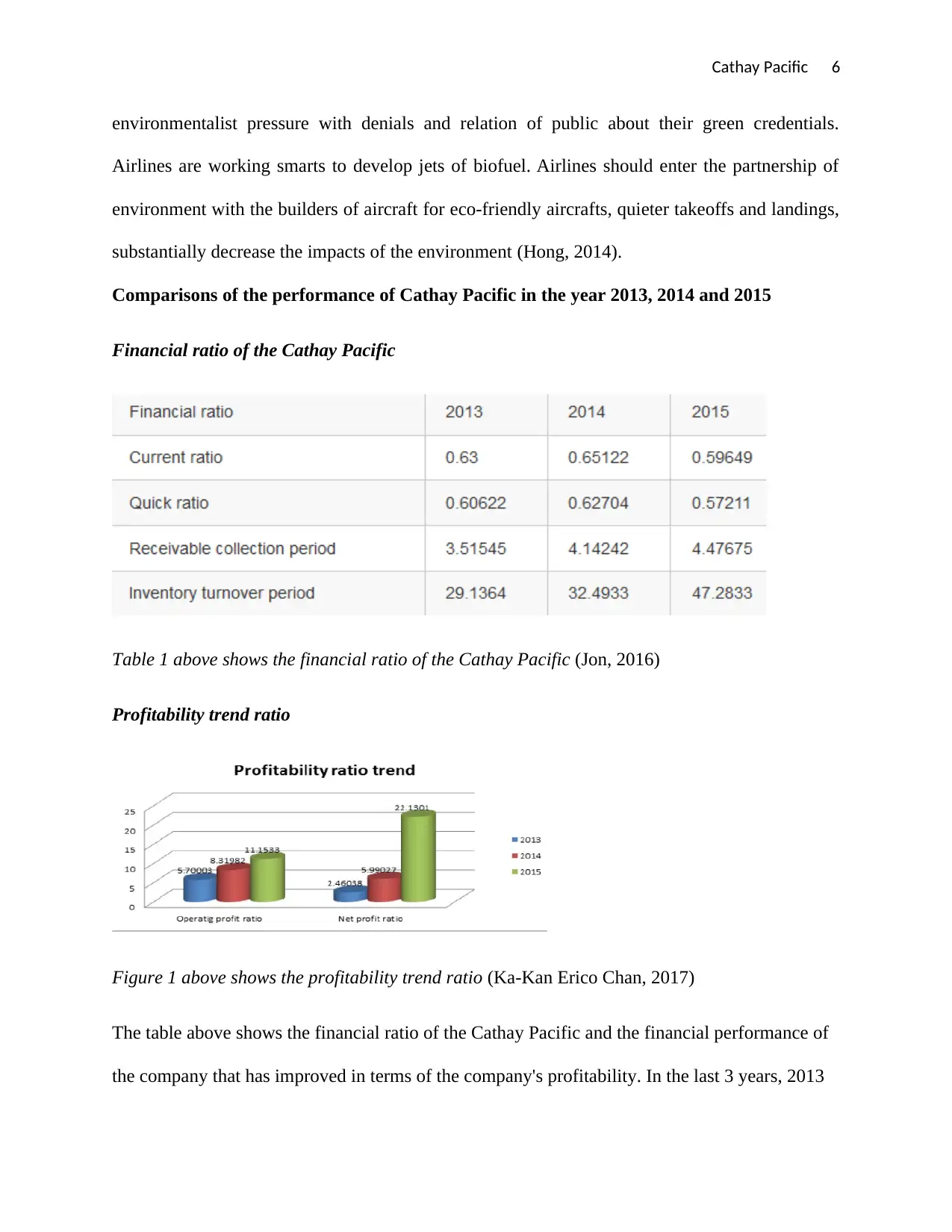
Cathay Pacific 6
environmentalist pressure with denials and relation of public about their green credentials.
Airlines are working smarts to develop jets of biofuel. Airlines should enter the partnership of
environment with the builders of aircraft for eco-friendly aircrafts, quieter takeoffs and landings,
substantially decrease the impacts of the environment (Hong, 2014).
Comparisons of the performance of Cathay Pacific in the year 2013, 2014 and 2015
Financial ratio of the Cathay Pacific
Table 1 above shows the financial ratio of the Cathay Pacific (Jon, 2016)
Profitability trend ratio
Figure 1 above shows the profitability trend ratio (Ka-Kan Erico Chan, 2017)
The table above shows the financial ratio of the Cathay Pacific and the financial performance of
the company that has improved in terms of the company's profitability. In the last 3 years, 2013
environmentalist pressure with denials and relation of public about their green credentials.
Airlines are working smarts to develop jets of biofuel. Airlines should enter the partnership of
environment with the builders of aircraft for eco-friendly aircrafts, quieter takeoffs and landings,
substantially decrease the impacts of the environment (Hong, 2014).
Comparisons of the performance of Cathay Pacific in the year 2013, 2014 and 2015
Financial ratio of the Cathay Pacific
Table 1 above shows the financial ratio of the Cathay Pacific (Jon, 2016)
Profitability trend ratio
Figure 1 above shows the profitability trend ratio (Ka-Kan Erico Chan, 2017)
The table above shows the financial ratio of the Cathay Pacific and the financial performance of
the company that has improved in terms of the company's profitability. In the last 3 years, 2013

Cathay Pacific 7
to 2015, the profit of operation of the Cathay Pacific have gradually increased. In 2013, the ratio
of the profit of operation for the Cathay Pacific was 5 and improved to 8. In 2014 and 11 in
2015. It can be seen that the profit increment of the company in 2015 was advanced than in the
year 2013. The change in the ratio of net profit of the company in last three years was 16
Liquidity trend ratio
Figure 2 above shows the liquidity trend ratio (Kong, 2014)
The liquid ratio of the company has reduced from 2013 to 2015, though the %of the liquid ratio
was just normal.
Efficiency ratio trend
Figure 3 above shows the efficiency trend ratio (Limited, 2015)
Results 2015 2014 2013
Revenue 103, 000 106,000 100,484
Attributable profit to the
Cathay Pacific’s
shareholders
6,000 3,150 2,620
Earnings 150.5 90.0 66.6
Dividend 0.60 0.40 0.22
Margin of profit 5.9 3.0 2.6
Funds attributed to the
Cathay Pacific’s
shareholders
48000 52000 62,888
Net borrowing 43000 44000 39,316
Funds of shareholders 13.0 14.0 15.9
to 2015, the profit of operation of the Cathay Pacific have gradually increased. In 2013, the ratio
of the profit of operation for the Cathay Pacific was 5 and improved to 8. In 2014 and 11 in
2015. It can be seen that the profit increment of the company in 2015 was advanced than in the
year 2013. The change in the ratio of net profit of the company in last three years was 16
Liquidity trend ratio
Figure 2 above shows the liquidity trend ratio (Kong, 2014)
The liquid ratio of the company has reduced from 2013 to 2015, though the %of the liquid ratio
was just normal.
Efficiency ratio trend
Figure 3 above shows the efficiency trend ratio (Limited, 2015)
Results 2015 2014 2013
Revenue 103, 000 106,000 100,484
Attributable profit to the
Cathay Pacific’s
shareholders
6,000 3,150 2,620
Earnings 150.5 90.0 66.6
Dividend 0.60 0.40 0.22
Margin of profit 5.9 3.0 2.6
Funds attributed to the
Cathay Pacific’s
shareholders
48000 52000 62,888
Net borrowing 43000 44000 39,316
Funds of shareholders 13.0 14.0 15.9
Paraphrase This Document
Need a fresh take? Get an instant paraphrase of this document with our AI Paraphraser
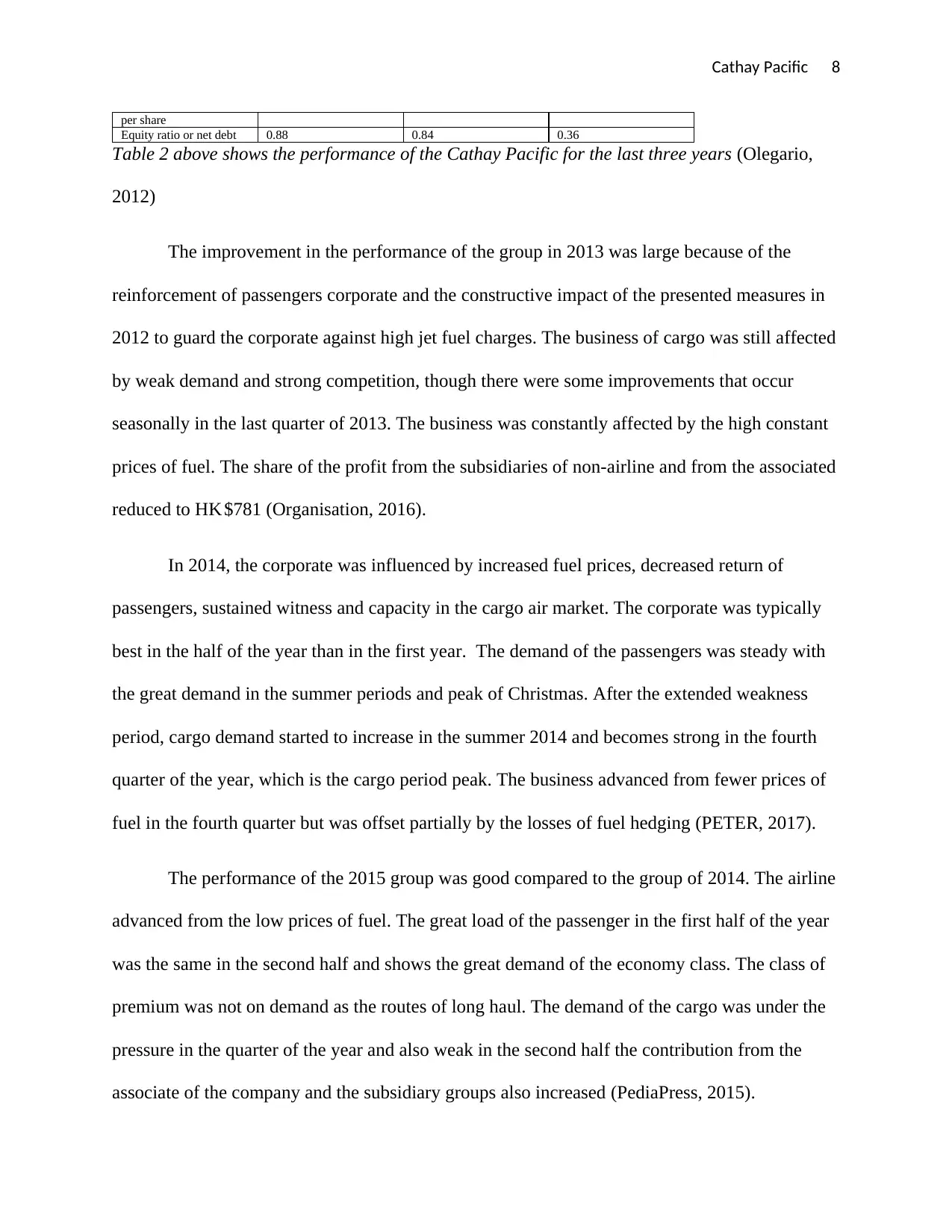
Cathay Pacific 8
per share
Equity ratio or net debt 0.88 0.84 0.36
Table 2 above shows the performance of the Cathay Pacific for the last three years (Olegario,
2012)
The improvement in the performance of the group in 2013 was large because of the
reinforcement of passengers corporate and the constructive impact of the presented measures in
2012 to guard the corporate against high jet fuel charges. The business of cargo was still affected
by weak demand and strong competition, though there were some improvements that occur
seasonally in the last quarter of 2013. The business was constantly affected by the high constant
prices of fuel. The share of the profit from the subsidiaries of non-airline and from the associated
reduced to HK $781 (Organisation, 2016).
In 2014, the corporate was influenced by increased fuel prices, decreased return of
passengers, sustained witness and capacity in the cargo air market. The corporate was typically
best in the half of the year than in the first year. The demand of the passengers was steady with
the great demand in the summer periods and peak of Christmas. After the extended weakness
period, cargo demand started to increase in the summer 2014 and becomes strong in the fourth
quarter of the year, which is the cargo period peak. The business advanced from fewer prices of
fuel in the fourth quarter but was offset partially by the losses of fuel hedging (PETER, 2017).
The performance of the 2015 group was good compared to the group of 2014. The airline
advanced from the low prices of fuel. The great load of the passenger in the first half of the year
was the same in the second half and shows the great demand of the economy class. The class of
premium was not on demand as the routes of long haul. The demand of the cargo was under the
pressure in the quarter of the year and also weak in the second half the contribution from the
associate of the company and the subsidiary groups also increased (PediaPress, 2015).
per share
Equity ratio or net debt 0.88 0.84 0.36
Table 2 above shows the performance of the Cathay Pacific for the last three years (Olegario,
2012)
The improvement in the performance of the group in 2013 was large because of the
reinforcement of passengers corporate and the constructive impact of the presented measures in
2012 to guard the corporate against high jet fuel charges. The business of cargo was still affected
by weak demand and strong competition, though there were some improvements that occur
seasonally in the last quarter of 2013. The business was constantly affected by the high constant
prices of fuel. The share of the profit from the subsidiaries of non-airline and from the associated
reduced to HK $781 (Organisation, 2016).
In 2014, the corporate was influenced by increased fuel prices, decreased return of
passengers, sustained witness and capacity in the cargo air market. The corporate was typically
best in the half of the year than in the first year. The demand of the passengers was steady with
the great demand in the summer periods and peak of Christmas. After the extended weakness
period, cargo demand started to increase in the summer 2014 and becomes strong in the fourth
quarter of the year, which is the cargo period peak. The business advanced from fewer prices of
fuel in the fourth quarter but was offset partially by the losses of fuel hedging (PETER, 2017).
The performance of the 2015 group was good compared to the group of 2014. The airline
advanced from the low prices of fuel. The great load of the passenger in the first half of the year
was the same in the second half and shows the great demand of the economy class. The class of
premium was not on demand as the routes of long haul. The demand of the cargo was under the
pressure in the quarter of the year and also weak in the second half the contribution from the
associate of the company and the subsidiary groups also increased (PediaPress, 2015).

Cathay Pacific 9
Market strategies of the Cathay Pacific in the year 2013, 2014 and 2015
The installation of the new seats of business class of the Boeing and Airbus long-haul
aircraft was finished in 2013 and the long haul business class seat on Boeing 747-400and Airbus
A340-300 aircraft was improved. The fitting of the new economy class seat on the long haul
Boeing and the Airbus aircraft was finished this year. The premium economy class was ready on
the aircraft of 85 in the year 2013. New systems of entertainment and monitors of touch screen
were installed in the economy class in the aircraft with regional seats of business class. Video
and audio on the demand were available for the passengers through private monitor TV, classy
glassware, crockery, and cutlery were introduced (Press, 2014).
The lounge of the first class and the wing at the intercontinental airport of Hong Kong
was reopened following the wide restoration. There was a new list of options at the haven, a new
inn and restored bathhouses with bath and shower amenities. A fifty daily flight to London were
added and their demand has been very strong and weekly services were also introduced. The
centre for IT innovation was introduced in this year and mobile fast to simplify boarding and
check-in. The electronic system for retrieving, recording and maintenance of aircraft and many
pages were converted in the format of electronic (Research, 2016).
In 2014, the restored lounge was opened at Penang international airport. Streamed digital
magazines and newspapers were given to the passengers in the lounges in Hong Kong
international airport. Cathay Pacific introduces services of daily to Doha and Qatar Airways, also
the networks were reorganized in the Middle East and the flight to Abu Dhabi was stopped and
improved the scheduled to the routes of Middle East. Daily services were introduced to network,
Manchester, Zurich and Dusseldorf. Dragonair stated going to Penang as the Cathay Pacific
stopped. The airborne trial of the enabling technology of aircraft and the system of ground stated
Market strategies of the Cathay Pacific in the year 2013, 2014 and 2015
The installation of the new seats of business class of the Boeing and Airbus long-haul
aircraft was finished in 2013 and the long haul business class seat on Boeing 747-400and Airbus
A340-300 aircraft was improved. The fitting of the new economy class seat on the long haul
Boeing and the Airbus aircraft was finished this year. The premium economy class was ready on
the aircraft of 85 in the year 2013. New systems of entertainment and monitors of touch screen
were installed in the economy class in the aircraft with regional seats of business class. Video
and audio on the demand were available for the passengers through private monitor TV, classy
glassware, crockery, and cutlery were introduced (Press, 2014).
The lounge of the first class and the wing at the intercontinental airport of Hong Kong
was reopened following the wide restoration. There was a new list of options at the haven, a new
inn and restored bathhouses with bath and shower amenities. A fifty daily flight to London were
added and their demand has been very strong and weekly services were also introduced. The
centre for IT innovation was introduced in this year and mobile fast to simplify boarding and
check-in. The electronic system for retrieving, recording and maintenance of aircraft and many
pages were converted in the format of electronic (Research, 2016).
In 2014, the restored lounge was opened at Penang international airport. Streamed digital
magazines and newspapers were given to the passengers in the lounges in Hong Kong
international airport. Cathay Pacific introduces services of daily to Doha and Qatar Airways, also
the networks were reorganized in the Middle East and the flight to Abu Dhabi was stopped and
improved the scheduled to the routes of Middle East. Daily services were introduced to network,
Manchester, Zurich and Dusseldorf. Dragonair stated going to Penang as the Cathay Pacific
stopped. The airborne trial of the enabling technology of aircraft and the system of ground stated
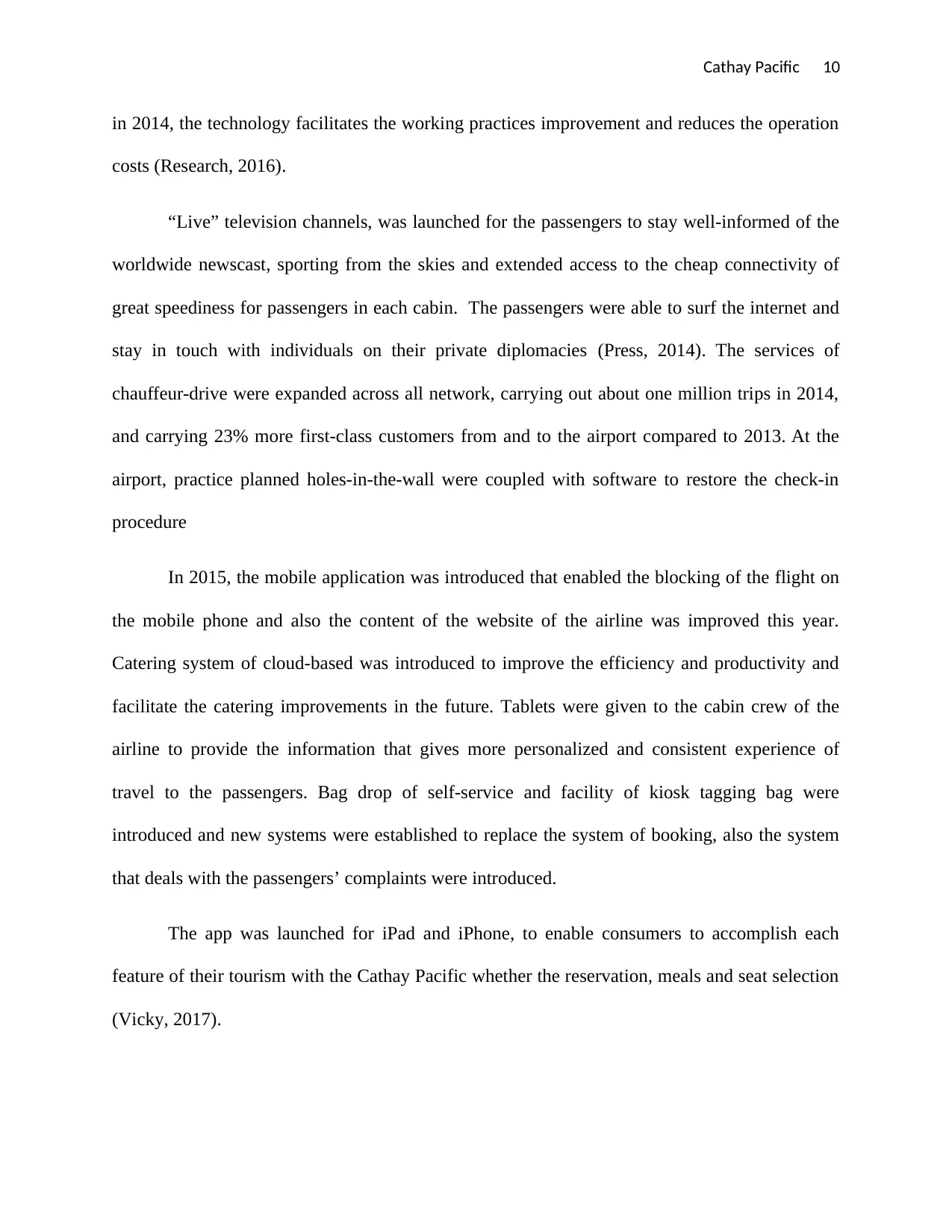
Cathay Pacific 10
in 2014, the technology facilitates the working practices improvement and reduces the operation
costs (Research, 2016).
“Live” television channels, was launched for the passengers to stay well-informed of the
worldwide newscast, sporting from the skies and extended access to the cheap connectivity of
great speediness for passengers in each cabin. The passengers were able to surf the internet and
stay in touch with individuals on their private diplomacies (Press, 2014). The services of
chauffeur-drive were expanded across all network, carrying out about one million trips in 2014,
and carrying 23% more first-class customers from and to the airport compared to 2013. At the
airport, practice planned holes-in-the-wall were coupled with software to restore the check-in
procedure
In 2015, the mobile application was introduced that enabled the blocking of the flight on
the mobile phone and also the content of the website of the airline was improved this year.
Catering system of cloud-based was introduced to improve the efficiency and productivity and
facilitate the catering improvements in the future. Tablets were given to the cabin crew of the
airline to provide the information that gives more personalized and consistent experience of
travel to the passengers. Bag drop of self-service and facility of kiosk tagging bag were
introduced and new systems were established to replace the system of booking, also the system
that deals with the passengers’ complaints were introduced.
The app was launched for iPad and iPhone, to enable consumers to accomplish each
feature of their tourism with the Cathay Pacific whether the reservation, meals and seat selection
(Vicky, 2017).
in 2014, the technology facilitates the working practices improvement and reduces the operation
costs (Research, 2016).
“Live” television channels, was launched for the passengers to stay well-informed of the
worldwide newscast, sporting from the skies and extended access to the cheap connectivity of
great speediness for passengers in each cabin. The passengers were able to surf the internet and
stay in touch with individuals on their private diplomacies (Press, 2014). The services of
chauffeur-drive were expanded across all network, carrying out about one million trips in 2014,
and carrying 23% more first-class customers from and to the airport compared to 2013. At the
airport, practice planned holes-in-the-wall were coupled with software to restore the check-in
procedure
In 2015, the mobile application was introduced that enabled the blocking of the flight on
the mobile phone and also the content of the website of the airline was improved this year.
Catering system of cloud-based was introduced to improve the efficiency and productivity and
facilitate the catering improvements in the future. Tablets were given to the cabin crew of the
airline to provide the information that gives more personalized and consistent experience of
travel to the passengers. Bag drop of self-service and facility of kiosk tagging bag were
introduced and new systems were established to replace the system of booking, also the system
that deals with the passengers’ complaints were introduced.
The app was launched for iPad and iPhone, to enable consumers to accomplish each
feature of their tourism with the Cathay Pacific whether the reservation, meals and seat selection
(Vicky, 2017).
Secure Best Marks with AI Grader
Need help grading? Try our AI Grader for instant feedback on your assignments.
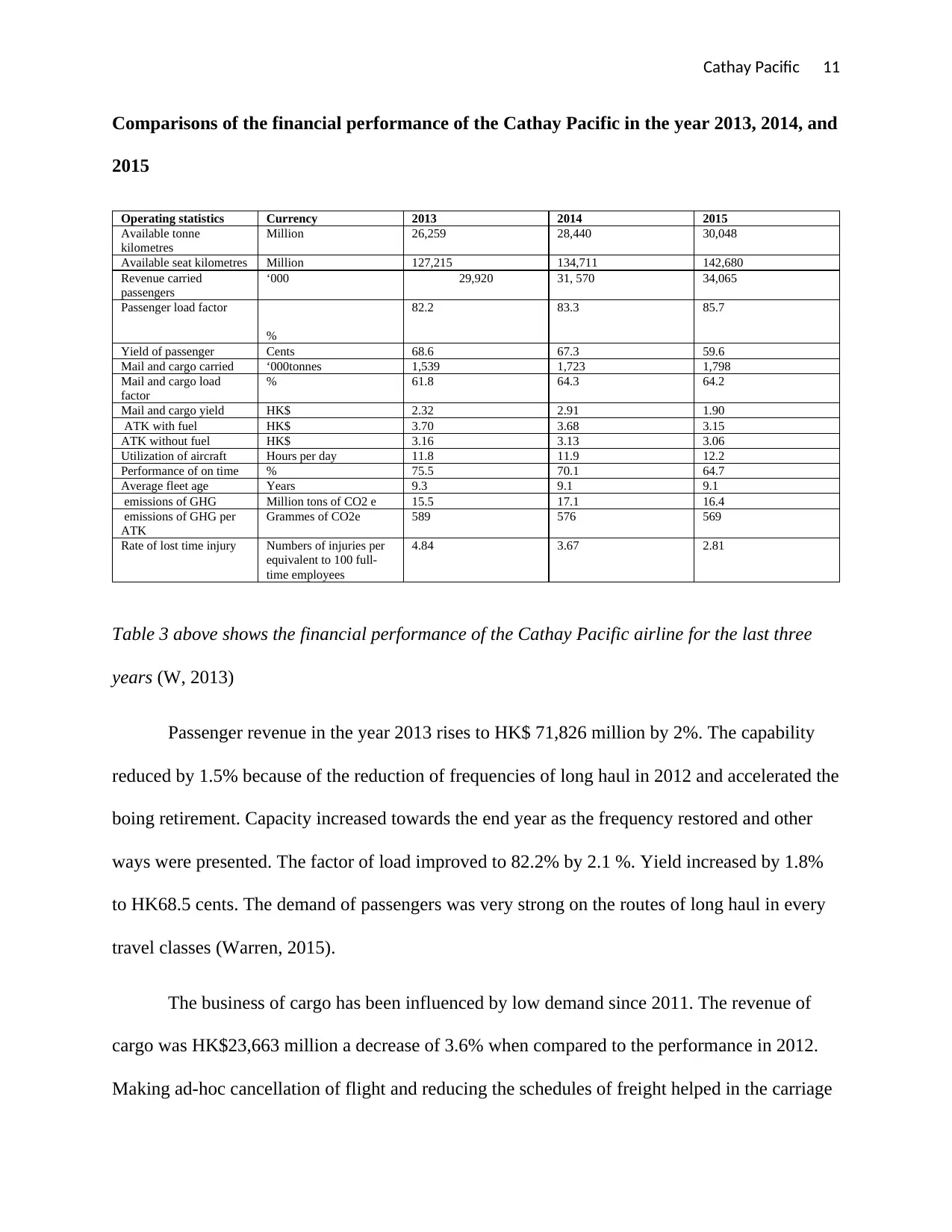
Cathay Pacific 11
Comparisons of the financial performance of the Cathay Pacific in the year 2013, 2014, and
2015
Operating statistics Currency 2013 2014 2015
Available tonne
kilometres
Million 26,259 28,440 30,048
Available seat kilometres Million 127,215 134,711 142,680
Revenue carried
passengers
‘000 29,920 31, 570 34,065
Passenger load factor
%
82.2 83.3 85.7
Yield of passenger Cents 68.6 67.3 59.6
Mail and cargo carried ‘000tonnes 1,539 1,723 1,798
Mail and cargo load
factor
% 61.8 64.3 64.2
Mail and cargo yield HK$ 2.32 2.91 1.90
ATK with fuel HK$ 3.70 3.68 3.15
ATK without fuel HK$ 3.16 3.13 3.06
Utilization of aircraft Hours per day 11.8 11.9 12.2
Performance of on time % 75.5 70.1 64.7
Average fleet age Years 9.3 9.1 9.1
emissions of GHG Million tons of CO2 e 15.5 17.1 16.4
emissions of GHG per
ATK
Grammes of CO2e 589 576 569
Rate of lost time injury Numbers of injuries per
equivalent to 100 full-
time employees
4.84 3.67 2.81
Table 3 above shows the financial performance of the Cathay Pacific airline for the last three
years (W, 2013)
Passenger revenue in the year 2013 rises to HK$ 71,826 million by 2%. The capability
reduced by 1.5% because of the reduction of frequencies of long haul in 2012 and accelerated the
boing retirement. Capacity increased towards the end year as the frequency restored and other
ways were presented. The factor of load improved to 82.2% by 2.1 %. Yield increased by 1.8%
to HK68.5 cents. The demand of passengers was very strong on the routes of long haul in every
travel classes (Warren, 2015).
The business of cargo has been influenced by low demand since 2011. The revenue of
cargo was HK$23,663 million a decrease of 3.6% when compared to the performance in 2012.
Making ad-hoc cancellation of flight and reducing the schedules of freight helped in the carriage
Comparisons of the financial performance of the Cathay Pacific in the year 2013, 2014, and
2015
Operating statistics Currency 2013 2014 2015
Available tonne
kilometres
Million 26,259 28,440 30,048
Available seat kilometres Million 127,215 134,711 142,680
Revenue carried
passengers
‘000 29,920 31, 570 34,065
Passenger load factor
%
82.2 83.3 85.7
Yield of passenger Cents 68.6 67.3 59.6
Mail and cargo carried ‘000tonnes 1,539 1,723 1,798
Mail and cargo load
factor
% 61.8 64.3 64.2
Mail and cargo yield HK$ 2.32 2.91 1.90
ATK with fuel HK$ 3.70 3.68 3.15
ATK without fuel HK$ 3.16 3.13 3.06
Utilization of aircraft Hours per day 11.8 11.9 12.2
Performance of on time % 75.5 70.1 64.7
Average fleet age Years 9.3 9.1 9.1
emissions of GHG Million tons of CO2 e 15.5 17.1 16.4
emissions of GHG per
ATK
Grammes of CO2e 589 576 569
Rate of lost time injury Numbers of injuries per
equivalent to 100 full-
time employees
4.84 3.67 2.81
Table 3 above shows the financial performance of the Cathay Pacific airline for the last three
years (W, 2013)
Passenger revenue in the year 2013 rises to HK$ 71,826 million by 2%. The capability
reduced by 1.5% because of the reduction of frequencies of long haul in 2012 and accelerated the
boing retirement. Capacity increased towards the end year as the frequency restored and other
ways were presented. The factor of load improved to 82.2% by 2.1 %. Yield increased by 1.8%
to HK68.5 cents. The demand of passengers was very strong on the routes of long haul in every
travel classes (Warren, 2015).
The business of cargo has been influenced by low demand since 2011. The revenue of
cargo was HK$23,663 million a decrease of 3.6% when compared to the performance in 2012.
Making ad-hoc cancellation of flight and reducing the schedules of freight helped in the carriage

Cathay Pacific 12
of more cargo in the passenger aircraft. The price of fuel of jet accounts for 39% of the total cost
of operation in 2013. The groups’ fuel in 2013 reduced by 4.6% as compared to 2012 as an
outcome of outline measures of 2012 like changing the schedule, capacity reduction, older
withdrawal and less efficient aircraft (Young, 2014).
The revenue of the passenger group for 2014 improved to HK$ 75,734 million by 5%.
Capacity rises by 5.9% because of the establishment of other routes and raised regularities of
available routes. The factor of the load improved by points of 1.1 % to 31.6 million. Yield
reduced to HK 67.3 cents by 1.8 percent. After the longtime of weakness, the demand for cargo
improves in the summer of the year 2014 and become so strong in the fourth quarter of the year.
The revenue of the group cargo rises to HK$25,000 million by 7.3% compared to 2013. In 2014,
the cost of fuel rises by 0.7 percent compared to the previous year, importantly below the cargo
and passenger capacity increase of 5.9 and 10.4 percent. The consumption of fuel was high
because many flights were being operated but this problem ended by the introduction of aircraft
of less fuel efficient (Airways, 2017).
Overcapacity in the market cargo put the compression on the first year’s rates. The rates
improved in the second half due to the demand improve or the shipment from the mainland
China and Hong Kong. The carried tonnage rises by around 12percent compared to the previous
year. The revenue of the passenger group in 2015 was HK$ 73,000 million, a reduction of 3.5
when compared to 2014. There was the increase in capacity because of the introduction of the
new route and the frequency increase in the routes. The load factor increased by 2.4% to 85%.
Stiff competition, a reduction in the surcharges fuel, unfavorable currencies and the fact that the
Hong Kong was used by the passengers to connect put the downward pressure on the yield that
reduced by 11 percent (Airways, 2016).
of more cargo in the passenger aircraft. The price of fuel of jet accounts for 39% of the total cost
of operation in 2013. The groups’ fuel in 2013 reduced by 4.6% as compared to 2012 as an
outcome of outline measures of 2012 like changing the schedule, capacity reduction, older
withdrawal and less efficient aircraft (Young, 2014).
The revenue of the passenger group for 2014 improved to HK$ 75,734 million by 5%.
Capacity rises by 5.9% because of the establishment of other routes and raised regularities of
available routes. The factor of the load improved by points of 1.1 % to 31.6 million. Yield
reduced to HK 67.3 cents by 1.8 percent. After the longtime of weakness, the demand for cargo
improves in the summer of the year 2014 and become so strong in the fourth quarter of the year.
The revenue of the group cargo rises to HK$25,000 million by 7.3% compared to 2013. In 2014,
the cost of fuel rises by 0.7 percent compared to the previous year, importantly below the cargo
and passenger capacity increase of 5.9 and 10.4 percent. The consumption of fuel was high
because many flights were being operated but this problem ended by the introduction of aircraft
of less fuel efficient (Airways, 2017).
Overcapacity in the market cargo put the compression on the first year’s rates. The rates
improved in the second half due to the demand improve or the shipment from the mainland
China and Hong Kong. The carried tonnage rises by around 12percent compared to the previous
year. The revenue of the passenger group in 2015 was HK$ 73,000 million, a reduction of 3.5
when compared to 2014. There was the increase in capacity because of the introduction of the
new route and the frequency increase in the routes. The load factor increased by 2.4% to 85%.
Stiff competition, a reduction in the surcharges fuel, unfavorable currencies and the fact that the
Hong Kong was used by the passengers to connect put the downward pressure on the yield that
reduced by 11 percent (Airways, 2016).
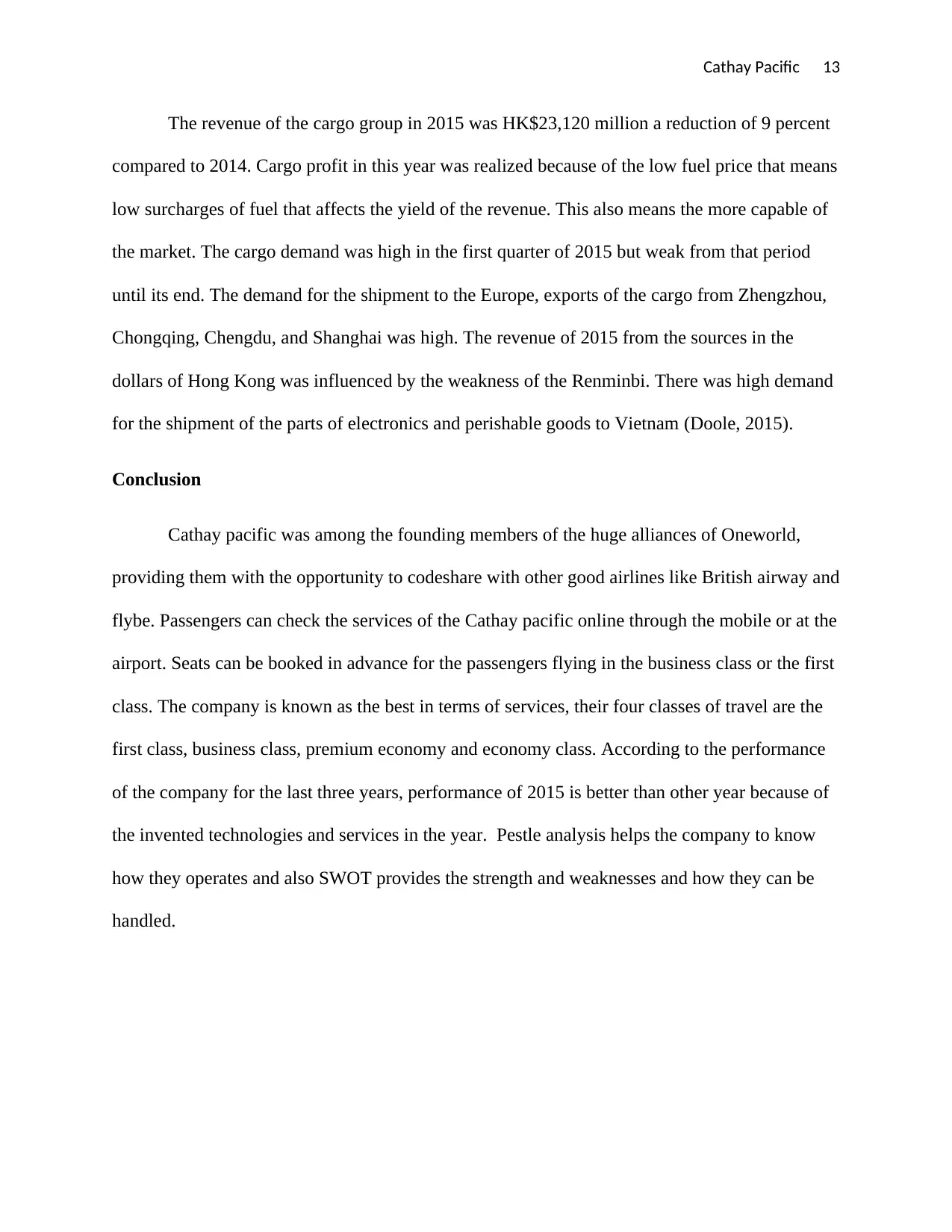
Cathay Pacific 13
The revenue of the cargo group in 2015 was HK$23,120 million a reduction of 9 percent
compared to 2014. Cargo profit in this year was realized because of the low fuel price that means
low surcharges of fuel that affects the yield of the revenue. This also means the more capable of
the market. The cargo demand was high in the first quarter of 2015 but weak from that period
until its end. The demand for the shipment to the Europe, exports of the cargo from Zhengzhou,
Chongqing, Chengdu, and Shanghai was high. The revenue of 2015 from the sources in the
dollars of Hong Kong was influenced by the weakness of the Renminbi. There was high demand
for the shipment of the parts of electronics and perishable goods to Vietnam (Doole, 2015).
Conclusion
Cathay pacific was among the founding members of the huge alliances of Oneworld,
providing them with the opportunity to codeshare with other good airlines like British airway and
flybe. Passengers can check the services of the Cathay pacific online through the mobile or at the
airport. Seats can be booked in advance for the passengers flying in the business class or the first
class. The company is known as the best in terms of services, their four classes of travel are the
first class, business class, premium economy and economy class. According to the performance
of the company for the last three years, performance of 2015 is better than other year because of
the invented technologies and services in the year. Pestle analysis helps the company to know
how they operates and also SWOT provides the strength and weaknesses and how they can be
handled.
The revenue of the cargo group in 2015 was HK$23,120 million a reduction of 9 percent
compared to 2014. Cargo profit in this year was realized because of the low fuel price that means
low surcharges of fuel that affects the yield of the revenue. This also means the more capable of
the market. The cargo demand was high in the first quarter of 2015 but weak from that period
until its end. The demand for the shipment to the Europe, exports of the cargo from Zhengzhou,
Chongqing, Chengdu, and Shanghai was high. The revenue of 2015 from the sources in the
dollars of Hong Kong was influenced by the weakness of the Renminbi. There was high demand
for the shipment of the parts of electronics and perishable goods to Vietnam (Doole, 2015).
Conclusion
Cathay pacific was among the founding members of the huge alliances of Oneworld,
providing them with the opportunity to codeshare with other good airlines like British airway and
flybe. Passengers can check the services of the Cathay pacific online through the mobile or at the
airport. Seats can be booked in advance for the passengers flying in the business class or the first
class. The company is known as the best in terms of services, their four classes of travel are the
first class, business class, premium economy and economy class. According to the performance
of the company for the last three years, performance of 2015 is better than other year because of
the invented technologies and services in the year. Pestle analysis helps the company to know
how they operates and also SWOT provides the strength and weaknesses and how they can be
handled.
Paraphrase This Document
Need a fresh take? Get an instant paraphrase of this document with our AI Paraphraser
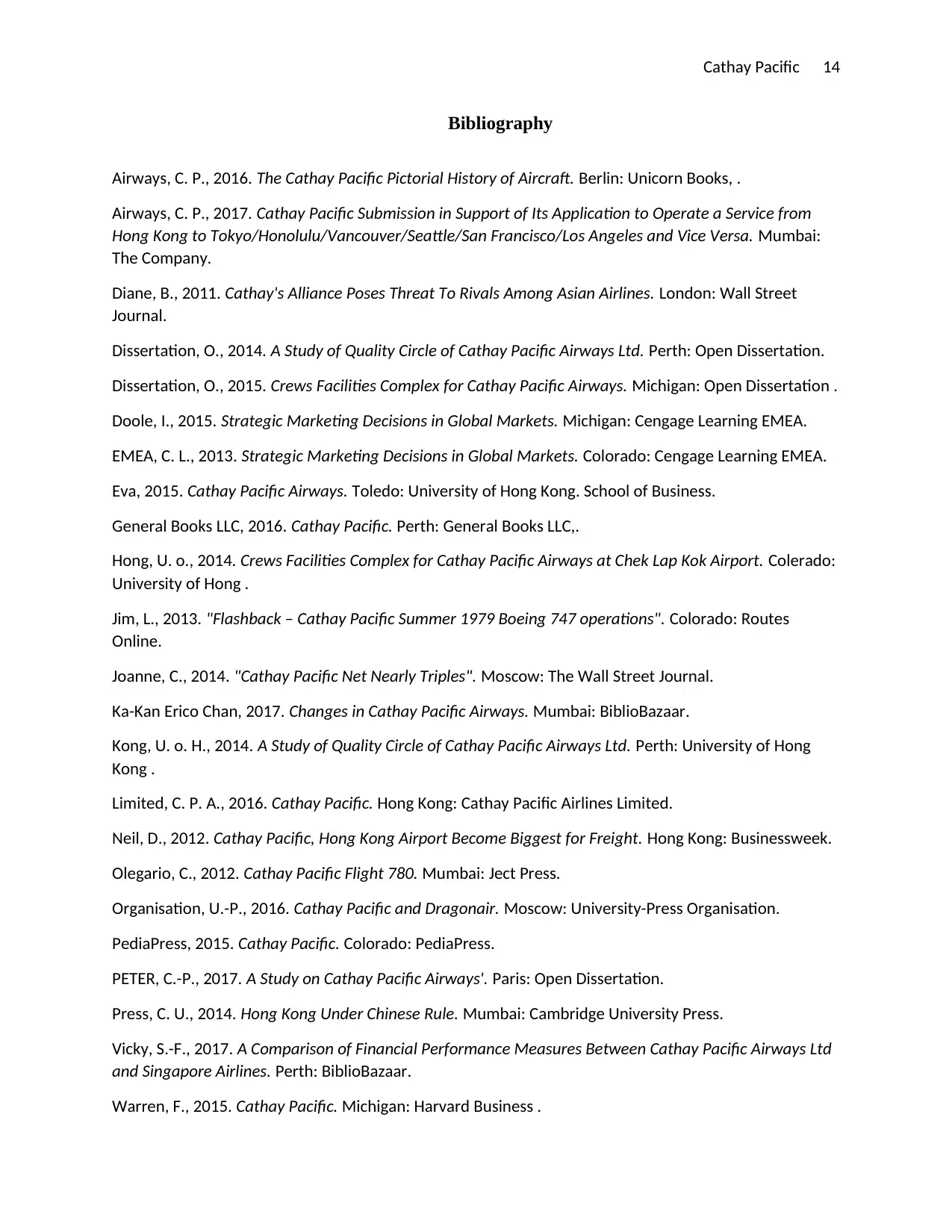
Cathay Pacific 14
Bibliography
Airways, C. P., 2016. The Cathay Pacific Pictorial History of Aircraft. Berlin: Unicorn Books, .
Airways, C. P., 2017. Cathay Pacific Submission in Support of Its Application to Operate a Service from
Hong Kong to Tokyo/Honolulu/Vancouver/Seattle/San Francisco/Los Angeles and Vice Versa. Mumbai:
The Company.
Diane, B., 2011. Cathay's Alliance Poses Threat To Rivals Among Asian Airlines. London: Wall Street
Journal.
Dissertation, O., 2014. A Study of Quality Circle of Cathay Pacific Airways Ltd. Perth: Open Dissertation.
Dissertation, O., 2015. Crews Facilities Complex for Cathay Pacific Airways. Michigan: Open Dissertation .
Doole, I., 2015. Strategic Marketing Decisions in Global Markets. Michigan: Cengage Learning EMEA.
EMEA, C. L., 2013. Strategic Marketing Decisions in Global Markets. Colorado: Cengage Learning EMEA.
Eva, 2015. Cathay Pacific Airways. Toledo: University of Hong Kong. School of Business.
General Books LLC, 2016. Cathay Pacific. Perth: General Books LLC,.
Hong, U. o., 2014. Crews Facilities Complex for Cathay Pacific Airways at Chek Lap Kok Airport. Colerado:
University of Hong .
Jim, L., 2013. "Flashback – Cathay Pacific Summer 1979 Boeing 747 operations". Colorado: Routes
Online.
Joanne, C., 2014. "Cathay Pacific Net Nearly Triples". Moscow: The Wall Street Journal.
Ka-Kan Erico Chan, 2017. Changes in Cathay Pacific Airways. Mumbai: BiblioBazaar.
Kong, U. o. H., 2014. A Study of Quality Circle of Cathay Pacific Airways Ltd. Perth: University of Hong
Kong .
Limited, C. P. A., 2016. Cathay Pacific. Hong Kong: Cathay Pacific Airlines Limited.
Neil, D., 2012. Cathay Pacific, Hong Kong Airport Become Biggest for Freight. Hong Kong: Businessweek.
Olegario, C., 2012. Cathay Pacific Flight 780. Mumbai: Ject Press.
Organisation, U.-P., 2016. Cathay Pacific and Dragonair. Moscow: University-Press Organisation.
PediaPress, 2015. Cathay Pacific. Colorado: PediaPress.
PETER, C.-P., 2017. A Study on Cathay Pacific Airways'. Paris: Open Dissertation.
Press, C. U., 2014. Hong Kong Under Chinese Rule. Mumbai: Cambridge University Press.
Vicky, S.-F., 2017. A Comparison of Financial Performance Measures Between Cathay Pacific Airways Ltd
and Singapore Airlines. Perth: BiblioBazaar.
Warren, F., 2015. Cathay Pacific. Michigan: Harvard Business .
Bibliography
Airways, C. P., 2016. The Cathay Pacific Pictorial History of Aircraft. Berlin: Unicorn Books, .
Airways, C. P., 2017. Cathay Pacific Submission in Support of Its Application to Operate a Service from
Hong Kong to Tokyo/Honolulu/Vancouver/Seattle/San Francisco/Los Angeles and Vice Versa. Mumbai:
The Company.
Diane, B., 2011. Cathay's Alliance Poses Threat To Rivals Among Asian Airlines. London: Wall Street
Journal.
Dissertation, O., 2014. A Study of Quality Circle of Cathay Pacific Airways Ltd. Perth: Open Dissertation.
Dissertation, O., 2015. Crews Facilities Complex for Cathay Pacific Airways. Michigan: Open Dissertation .
Doole, I., 2015. Strategic Marketing Decisions in Global Markets. Michigan: Cengage Learning EMEA.
EMEA, C. L., 2013. Strategic Marketing Decisions in Global Markets. Colorado: Cengage Learning EMEA.
Eva, 2015. Cathay Pacific Airways. Toledo: University of Hong Kong. School of Business.
General Books LLC, 2016. Cathay Pacific. Perth: General Books LLC,.
Hong, U. o., 2014. Crews Facilities Complex for Cathay Pacific Airways at Chek Lap Kok Airport. Colerado:
University of Hong .
Jim, L., 2013. "Flashback – Cathay Pacific Summer 1979 Boeing 747 operations". Colorado: Routes
Online.
Joanne, C., 2014. "Cathay Pacific Net Nearly Triples". Moscow: The Wall Street Journal.
Ka-Kan Erico Chan, 2017. Changes in Cathay Pacific Airways. Mumbai: BiblioBazaar.
Kong, U. o. H., 2014. A Study of Quality Circle of Cathay Pacific Airways Ltd. Perth: University of Hong
Kong .
Limited, C. P. A., 2016. Cathay Pacific. Hong Kong: Cathay Pacific Airlines Limited.
Neil, D., 2012. Cathay Pacific, Hong Kong Airport Become Biggest for Freight. Hong Kong: Businessweek.
Olegario, C., 2012. Cathay Pacific Flight 780. Mumbai: Ject Press.
Organisation, U.-P., 2016. Cathay Pacific and Dragonair. Moscow: University-Press Organisation.
PediaPress, 2015. Cathay Pacific. Colorado: PediaPress.
PETER, C.-P., 2017. A Study on Cathay Pacific Airways'. Paris: Open Dissertation.
Press, C. U., 2014. Hong Kong Under Chinese Rule. Mumbai: Cambridge University Press.
Vicky, S.-F., 2017. A Comparison of Financial Performance Measures Between Cathay Pacific Airways Ltd
and Singapore Airlines. Perth: BiblioBazaar.
Warren, F., 2015. Cathay Pacific. Michigan: Harvard Business .
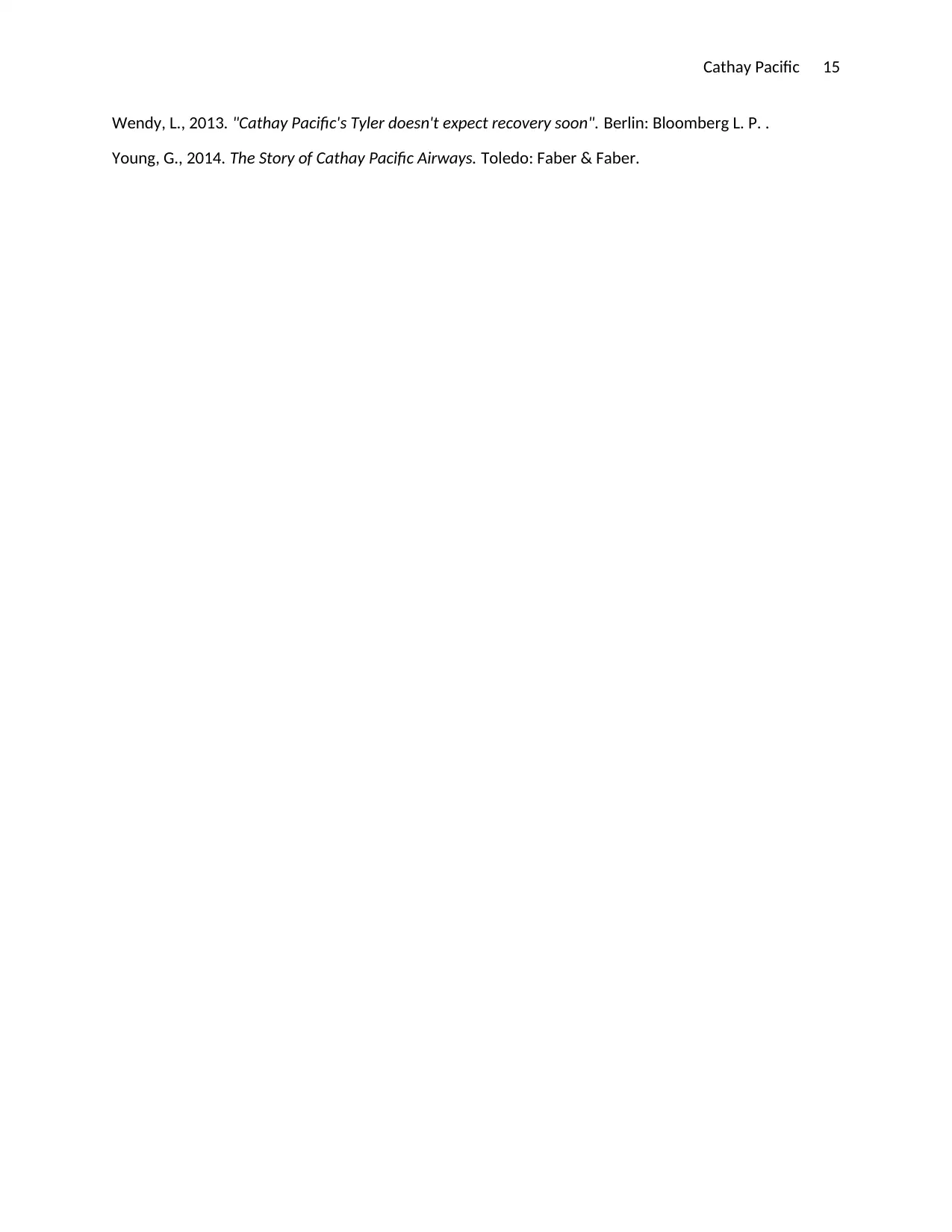
Cathay Pacific 15
Wendy, L., 2013. "Cathay Pacific's Tyler doesn't expect recovery soon". Berlin: Bloomberg L. P. .
Young, G., 2014. The Story of Cathay Pacific Airways. Toledo: Faber & Faber.
Wendy, L., 2013. "Cathay Pacific's Tyler doesn't expect recovery soon". Berlin: Bloomberg L. P. .
Young, G., 2014. The Story of Cathay Pacific Airways. Toledo: Faber & Faber.
1 out of 15
Related Documents
Your All-in-One AI-Powered Toolkit for Academic Success.
+13062052269
info@desklib.com
Available 24*7 on WhatsApp / Email
![[object Object]](/_next/static/media/star-bottom.7253800d.svg)
Unlock your academic potential
© 2024 | Zucol Services PVT LTD | All rights reserved.





